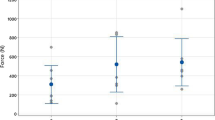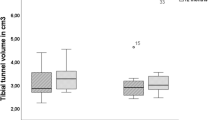Abstract
Purpose
Conventional press-fit technique for anterior cruciate ligament reconstruction (ACLR) is performed with extraction drilling of the femoral bone tunnel and manual sha** of the patellar bone plug. However, the disadvantages of this technique include variation in bone plug size and, thus, the strength of the press-fit fixation, bone loss with debris distribution within the knee joint, potential heat necrosis, and metal wear debris due to abrasion of the guide wire. To overcome these disadvantages, a novel technique involving punching of the femoral bone tunnel and standardized compression of the bone plug was introduced. In this study, the fixation strength and apparent stiffness were tested and compared to that of the gold-standard interference screw fixation technique in three flexion angle configurations (0°/45°/90°) in a porcine model. We hypothesized that the newly developed standardized press fit fixation would not be inferior to the gold standard method.
Methods
Sixty skeletally mature porcine knees (30 pairs) were used. Full-thickness central third patellar tendon strips were harvested, including a patellar bone cylinder of 9.5 mm in diameter. The specimens were randomly assigned to 10 pairs per loading angle (0°, 45°, 90°). One side of each pair was prepared with the press-fit technique, and the contra-lateral side was prepared with interference screw fixation. Equivalent numbers of left- and right-sided samples were used for both fixation systems. A three-way multifactor ANOVA was carried out to check for the influence of (a) fixation type, (b) flexion angle, and (c) side of the bone pair.
Results
The primary fixation strength of femoral press-fit graft fixation with punched tunnels and standardized bone plug compression did not differ significantly from that of interference screw fixation (p = 0.51), which had mean loads to failure of 422.4 ± 134.6 N and 445.4 ± 135.8 N, respectively. The flexion angle had a significant influence on the maximal load to failure (p = 0.01). Load values were highest in 45° flexion for both fixations. The anatomical side R/L was not a statistically significant factor (p = 0.79).
Conclusion
The primary fixation strength of femoral press-fit graft fixation with punched femoral tunnels and standardized bone plug compression is equivalent to that of interference screw fixation in a porcine model. Therefore, the procedure represents an effective method for ACL reconstruction with patellar or quadriceps tendon autografts including a patellar bone plug.









Similar content being viewed by others
Abbreviations
- ACL(R):
-
Anterior cruciate ligament (reconstruction)
- IS:
-
Interference screw
- PF:
-
Press-fit
References
Wenning M, Heitner AH, Mauch M et al (2020) The effect of meniscal repair on strength deficits 6 months after ACL reconstruction. Arch Orthop Trauma Surg 140:751–760. https://doi.org/10.1007/s00402-020-03347-0
Yan L, Li JJ, Zhu Y et al (2021) Interference screws are more likely to perform better than cortical button and cross-pin fixation for hamstring autograft in ACL reconstruction: a Bayesian network meta-analysis. Knee Surg, Sport Traumatol Arthrosc 29:1850–1861. https://doi.org/10.1007/s00167-020-06231-x
Barber FA, Dockery WD (2020) Biocomposite interference screws in anterior cruciate ligament reconstruction: osteoconductivity and degradation. Arthrosc Sport Med Rehabil 2:e53–e58. https://doi.org/10.1016/j.asmr.2019.10.001
Shumborski S, Heath E, Salmon LJ et al (2019) A randomized controlled trial of PEEK versus titanium interference screws for anterior cruciate ligament reconstruction with 2-year follow-up. Am J Sports Med 47:2386–2393. https://doi.org/10.1177/0363546519861530
Sundaraj K, Salmon LJ, Heath EL et al (2020) Bioabsorbable versus titanium screws in anterior cruciate ligament reconstruction using hamstring autograft: a prospective, randomized controlled trial with 13-year follow-up. Am J Sports Med 48:1316–1326. https://doi.org/10.1177/0363546520911024
Kramer DE, Kalish LA, Kocher MS et al (2020) Complications of bioabsorbable tibial interference screws after anterior cruciate ligament reconstruction in pediatric and adolescent athletes. Orthop J Sport Med 8:1–8. https://doi.org/10.1177/2325967120904010
Chiang ER, Chen KH, Chih-Chang Lin A et al (2019) Comparison of tunnel enlargement and clinical outcome between bioabsorbable interference screws and cortical button-post fixation in arthroscopic double-bundle anterior cruciate ligament reconstruction: a prospective, randomized study with a minimum follow up of 2 years. Arthrosc - J Arthrosc Relat Surg 35:544–551. https://doi.org/10.1016/j.arthro.2018.08.039
Akoto R, Albers M, Balke M et al (2019) ACL reconstruction with quadriceps tendon graft and press-fit fixation versus quadruple hamstring graft and interference screw fixation-a matched pair analysis after one year follow up. BMC Musculoskelet Disord. https://doi.org/10.1186/s12891-019-2499-y
Barié A, Sprinckstub T, Huber J, Jaber A (2020) Quadriceps tendon vs. patellar tendon autograft for ACL reconstruction using a hardware-free press-fit fixation technique: comparable stability, function and return-to-sport level but less donor site morbidity in athletes after 10 years. Arch Orthop Trauma Surg 140:1465–1474. https://doi.org/10.1007/s00402-020-03508-1
Horstmann H, Petri M, Tegtbur U et al (2021) Quadriceps and hamstring tendon autografts in ACL reconstruction yield comparably good results in a prospective, randomized controlled trial. Arch Orthop Trauma Surg. https://doi.org/10.1007/s00402-021-03862-8
Shanmugaraj A, Mahendralingam M, Gohal C et al (2021) Press-fit fixation in anterior cruciate ligament reconstruction yields low graft failure and revision rates: a systematic review and meta-analysis. Knee Surg, Sport Traumatol Arthrosc 29:1750–1759. https://doi.org/10.1007/s00167-020-06173-4
Brandl G, Ostermann RC, Pauzenberger L et al (2020) Bone-on-bone anatomic patellar tendon graft anterior cruciate ligament reconstruction: a reproducible technique combining press-fit and extracortical fixation. Arthrosc Tech 9:e205–e212. https://doi.org/10.1016/j.eats.2019.09.024
Dargel J, Schmidt-Wiethoff R, Brüggemann GP, Koebke J (2007) The effect of bone tunnel dilation versus extraction drilling on the initial fixation strength of press-fit anterior cruciate ligament reconstruction. Arch Orthop Trauma Surg 127:801–807. https://doi.org/10.1007/s00402-006-0206-6
MacDonald DRW, Bruce E, Stevenson I (2019) A novel technique for bone debris clearance during anterior cruciate ligament reconstruction. J Arthrosc Jt Surg 6:131–132. https://doi.org/10.1016/j.jajs.2018.12.002
Nagira K, Enokida M, Hayashi I et al (2021) A simple method to reduce the incidence of cyclops lesion after anterior cruciate ligament reconstruction. J Knee Surg 34:546–551. https://doi.org/10.1055/s-0039-1697625
Ugutmen E, Ozkan K, Güven M et al (2007) Early tunnel enlargement after arthroscopic ACL reconstructions. Acta Orthop Belg 73:625–629
Hart AJ, Buscombe J, Malone A, Dowd GSE (2005) Assessment of osteoarthritis after reconstruction of the anterior cruciate ligament. A study using single-photon emission computed tomography at ten years. J Bone Jt Sur-Ser B 87:1483–1487. https://doi.org/10.1302/0301-620X.87B11.16138
Wnorowski DC (1997) The fate of intra-articular debris following arthroscopic anterior cruciate ligament reconstruction. Arthroscopy 13:620–626. https://doi.org/10.1016/S0749-8063(97)90190-0
Seil R, Rupp S, Krauss PW et al (1998) Comparison of initial fixation strength between biodegradable and metallic interference screws and a press-fit fixation technique in a porcine model. Am J Sports Med 26:815–819. https://doi.org/10.1177/03635465980260061301
Schmidt-Wiethoff R, Dargel J, Gerstner M et al (2006) Bone plug length and loading angle determine the primary stability of patellar tendon-bone grafts in press-fit ACL reconstruction. Knee Surg, Sport Traumatol Arthrosc 14:108–111. https://doi.org/10.1007/s00167-005-0645-6
Hamdy R, Kiebzak GM, Seier E, Watts NB (2006) The prevalence of significant left-right differences in hip bone mineral density. Osteoporos Int 17:1772–1780. https://doi.org/10.1007/s00198-006-0192-0
Lee MC, Jo H, Bae TS et al (2003) Analysis of initial fixation strength of press-fit fixation technique in anterior cruciate ligament reconstruction: a comparative study with titanium and bioabsorbable interference screw using porcine lower limb. Knee Surg, Sport Traumatol Arthrosc 11:91–98. https://doi.org/10.1007/s00167-003-0351-1
Rupp S, Krauss PW, Fritsch EW (1997) Fixation strength of a biodegradable interference screw and a press-fit technique in anterior cruciate ligament reconstruction with a BPTB graft. Arthroscopy 13:61–65. https://doi.org/10.1016/S0749-8063(97)90210-3
Slone HS, Romine SE, Premkumar A, Xerogeanes JW (2015) Quadriceps tendon autograft for anterior cruciate ligament reconstruction: a comprehensive review of current literature and systematic review of clinical results. Arthrosc-J Arthrosc Relat Surg 31:541–554. https://doi.org/10.1016/j.arthro.2014.11.010
Escamilla RF, MacLeod TD, Wilk KE et al (2012) Anterior cruciate ligament strain and tensile forces for weight-bearing and non-weight-bearing exercises: a guide to exercise selectiona. J Orthop Sports Phys Ther 42:208–220. https://doi.org/10.2519/jospt.2012.3768
Toutoungi DE, Lu TW, Leardini A et al (2000) Cruciate ligament forces in the human knee during rehabilitation exercises. Clin Biomech 15:176–187. https://doi.org/10.1016/S0268-0033(99)00063-7
Shin CS, Chaudhari AM, Andriacchi TP (2007) The influence of deceleration forces on ACL strain during single-leg landing: a simulation study. J Biomech 40:1145–1152. https://doi.org/10.1016/j.jbiomech.2006.05.004
Foldager C, Jakobsen BW, Lund B et al (2010) Tibial tunnel widening after bioresorbable poly-lactide calcium carbonate interference screw usage in ACL reconstruction. Knee Surg, Sport Traumatol Arthrosc 18:79–84. https://doi.org/10.1007/s00167-009-0865-2
Lenschow S, Herbort M, Strässer A et al (2011) Structural properties of a new device for graft fixation in cruciate ligament reconstruction: the shim technique. Arch Orthop Trauma Surg 131:1067–1072. https://doi.org/10.1007/s00402-011-1276-7
Hantes ME, Zachos VC, Liantsis A et al (2009) Differences in graft orientation using the transtibial and anteromedial portal technique in anterior cruciate ligament reconstruction: a magnetic resonance imaging study. Knee Surg, Sport Traumatol Arthrosc 17:880–886. https://doi.org/10.1007/s00167-009-0738-8
Basdekis G, Christel P, Anne F (2009) Validation of the position of the femoral tunnels in anatomic double-bundle ACL reconstruction with 3-D CT scan. Knee Surg, Sport Traumatol Arthrosc 17:1089–1094. https://doi.org/10.1007/s00167-009-0829-6
Basdekis G, Abisafi C, Christel P (2009) Effect of knee flexion angle on length and orientation of posterolateral femoral tunnel drilled through anteromedial portal during anatomic double-bundle anterior cruciate ligament reconstruction. Arthrosc-J Arthrosc Relat Surg 25:1108–1114. https://doi.org/10.1016/j.arthro.2009.05.018
Acknowledgements
none.
Funding
Funding was received from the Lindenhof Foundation, Bern, Switzerland.
Author information
Authors and Affiliations
Contributions
JH designed the study, composed the manuscript concept, and wrote the manuscript. SV, AA, and TO conducted the biomechanical tests, performed all statistical analyses, and edited the complete manuscript. MH and JH operated on all cases and helped in editing the final draft version of the manuscript. SE supervised the study and helped in editing the final draft version of the manuscript. All authors read and approved the final manuscript.
Corresponding author
Ethics declarations
Conflict of interest
The authors declare that they have no conflict of interest.
Ethical approval
This article does not contain any studies with human participants or animals performed by any of the authors.
Additional information
Publisher's Note
Springer Nature remains neutral with regard to jurisdictional claims in published maps and institutional affiliations.
Rights and permissions
About this article
Cite this article
Häberli, J., Heilgemeir, M., Valet, S. et al. Novel press-fit technique of patellar bone plug in anterior cruciate ligament reconstruction is comparable to interference screw fixation. Arch Orthop Trauma Surg 142, 1963–1970 (2022). https://doi.org/10.1007/s00402-021-04137-y
Received:
Accepted:
Published:
Issue Date:
DOI: https://doi.org/10.1007/s00402-021-04137-y




